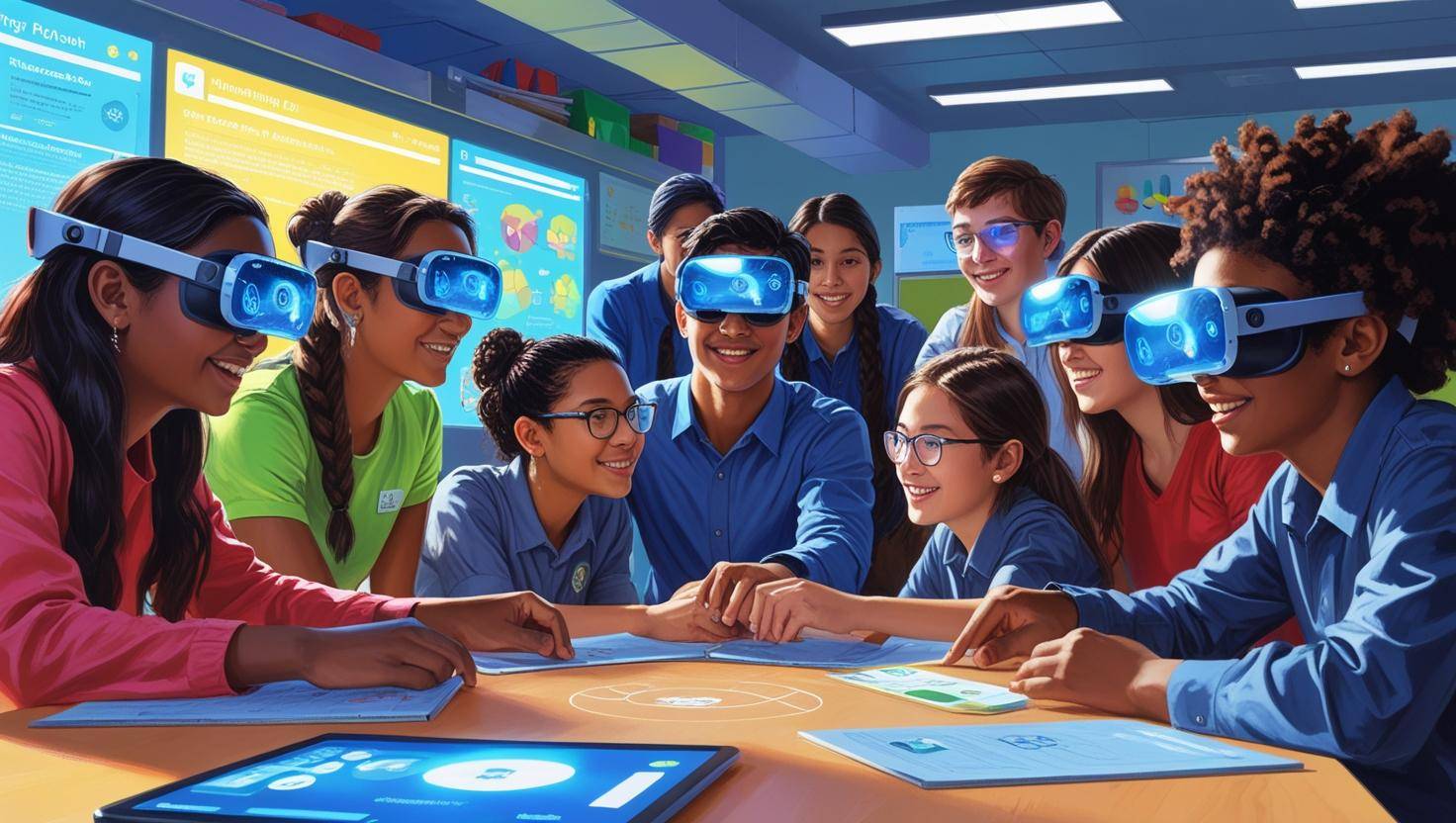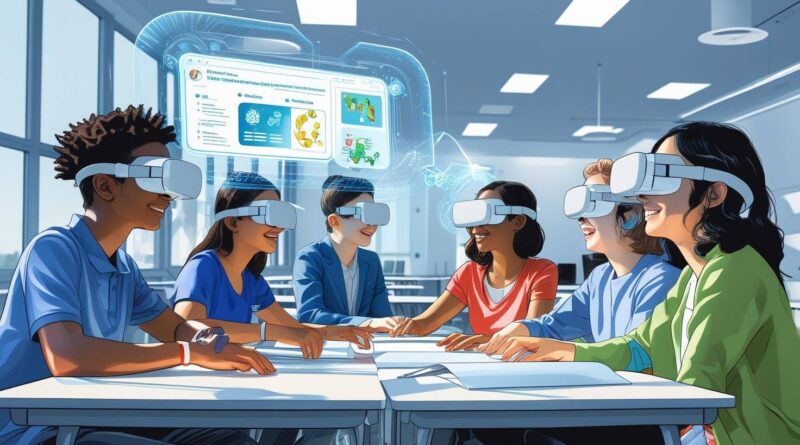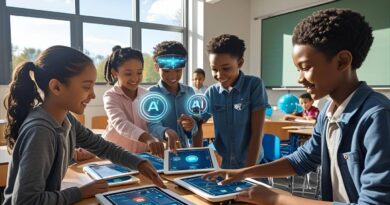VR and AR in Learning: Education in an Immersive World
Introduction
What Is Immersive Learning?
Imagine stepping inside a science lab without leaving your bedroom. Or walking through ancient Rome in history class. That’s the magic of immersive learning—where you’re not just reading or watching, but living the lesson. It uses technologies like Virtual Reality (VR) and Augmented Reality (AR) to create engaging, hands-on educational experiences that spark curiosity and boost understanding.
The Rise of VR and AR in Education
The classroom isn’t what it used to be. Chalkboards are replaced by smartboards, textbooks by tablets, and now… reality itself is getting a reboot. VR and AR are no longer just for gamers—they’re powerful tools shaping the future of education. Schools and universities across the globe are embracing immersive tech to create experiences that are more interactive, visual, and fun.
Understanding the Technology
What Is Virtual Reality (VR)?
Virtual Reality is a computer-generated environment that immerses users in a fully digital world. With the help of headsets like Oculus or HTC Vive, students can explore, manipulate, and interact with 3D environments—perfect for simulations and role-play scenarios.
Key Features of VR in Learning
- Full immersion: Students are placed in a completely virtual setting.
- High engagement: Learning becomes an adventure.
- Real-time interaction: Simulates hands-on learning, like surgery practice or chemical experiments.
What Is Augmented Reality (AR)?
Augmented Reality overlays digital information—like images, sounds, or text—on the real world. It doesn’t take you away from reality; it enhances it. Think Pokémon Go, but instead of catching creatures, you’re watching a 3D heart pump on your desk.
How AR Differs from VR in Education
- No headset required: Can be used on smartphones or tablets.
- Blends with real-world context: Ideal for field trips, object recognition, and live annotations.
The Convergence of VR, AR, and MR
Mixed Reality (MR) brings together the best of both worlds—merging real and virtual environments in a seamless experience. It’s the future frontier, promising even more intuitive, layered learning.
Benefits of VR and AR in Education
Enhancing Student Engagement
Traditional lectures can get boring fast. But when students can explore a rainforest or dissect a frog in 3D, engagement skyrockets. Immersive learning taps into curiosity and turns passive learning into active exploration.

Learning by Doing: Practical Skill Acquisition
You can read about CPR a hundred times, but practicing it in a VR simulation gives you the muscle memory and confidence needed in real emergencies. Whether it’s piloting a plane or fixing an engine, “learning by doing” becomes possible in safe, controlled digital spaces.
Breaking the Boundaries of Geography
AR and VR allow access to resources and environments that might be physically or financially out of reach—like visiting the Great Wall of China or orbiting the Earth—all from a classroom in a rural village.
Supporting Diverse Learning Styles
Visual learners thrive in AR experiences. Kinesthetic learners benefit from VR simulations. These tools adapt to different learning styles, helping more students succeed.
Safe and Controlled Simulations
From dangerous chemistry experiments to high-risk medical procedures, VR offers a risk-free way to train students in complex or hazardous skills.
Applications in Different Fields
STEM Education
Imagine programming a robot in 3D space or watching molecules form during a chemical reaction—VR and AR make STEM concepts tangible and intuitive.
Medical and Healthcare Training
VR surgeries and anatomy explorations prepare med students before they ever touch a scalpel. AR can project veins for phlebotomy practice, enhancing accuracy and reducing errors.
History and Social Studies
Time travel? Sort of. Walk through ancient civilizations, interact with historical figures, or explore battlefields in VR. History becomes personal and unforgettable.
Language Learning
Want to practice Spanish in a Mexican market? Or learn French while “walking” around Paris? VR provides immersive environments that boost language acquisition.
Arts and Design
From virtual sculpting to AR painting apps, creative students can experiment and express ideas in ways never before possible—without needing a physical studio.
Tools and Platforms for Immersive Learning
Top VR Tools for Education
- Google Expeditions – Virtual field trips to anywhere on Earth.
- zSpace – VR laptops with interactive learning modules.
- ENGAGE – A platform for virtual classrooms and events.
Popular AR Educational Apps
- Merge Cube – Lets you hold 3D objects in your hand.
- Quiver – Brings coloring pages to life.
- SkyView – Identifies stars and constellations in real-time.
Emerging Hardware for Classrooms
- Meta Quest 3 – Affordable, high-performance VR headset.
- Magic Leap – AR headset for advanced simulations.
- AR-enabled tablets – Increasingly common in schools worldwide.
Challenges and Limitations
Cost and Accessibility
Not every school can afford VR labs or AR devices. Bridging the digital divide is crucial if immersive tech is to benefit everyone.
Technical Barriers
Headsets can glitch. Apps might lag. Connectivity issues can disrupt experiences, especially in low-resource areas.
Health and Safety Concerns
Prolonged VR use may cause eye strain, motion sickness, or disorientation. Educators need to follow safety guidelines for screen time and device use.
Teacher Training and Curriculum Integration
Without proper training, even the best tech becomes useless. Teachers need support to confidently embed VR/AR in lesson plans.
The Future of VR and AR in Education
AI Integration with Immersive Tech
Smart tutors powered by AI could guide students inside VR worlds—offering hints, adapting lessons, or assessing progress in real time.
Personalized Learning in Virtual Worlds
Imagine a history lesson that changes based on your interests. Or a math game that gets harder as you improve. The future is personalized, adaptive, and incredibly immersive.
The Role of 5G and Cloud Computing
Faster internet and powerful cloud systems will unlock smoother, more detailed AR/VR experiences—accessible from virtually anywhere.
Conclusion
Education is evolving—and immersive technology is leading the charge. With VR and AR, learning becomes an experience, not just a task. Though there are challenges, the potential to revolutionize how we teach and learn is simply too big to ignore. Whether you’re a student, teacher, or tech lover, one thing’s clear: the future of education is not flat… it’s 3D.
FAQs
How is VR different from AR in education?
VR immerses students in a fully virtual environment, while AR adds digital elements to the real world—each with unique benefits for learning.
Can VR and AR replace traditional teaching methods?
Not entirely, but they can significantly enhance traditional methods by making learning more interactive and memorable.
Are VR and AR safe for children?
Yes, when used responsibly. Short, guided sessions are ideal to avoid eye strain or motion sickness.
What are the best AR/VR tools for beginners?
Apps like Google Expeditions, Merge Cube, and Quiver are great starting points for educators and learners.
Will immersive learning become the norm in the future?
As technology becomes more affordable and widespread, immersive learning is expected to become a key component of modern education.



